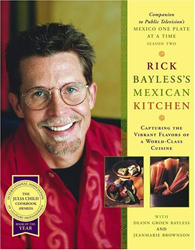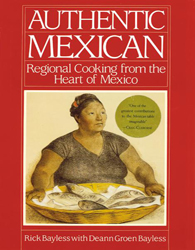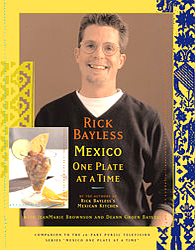|
|||||||||||||||||||||||||||||||||||||||||||||||||
Palapa Azul Mexican Ice Cream, Sorbet & Frozen Fruit Bars:
|
INDEX TO REVIEW |
MORE TO DISCOVER |
We’ve never been to Mexico to enjoy the native flavors of ice cream, sorbets and ice bars that vacationers return raving about. Now we don’t have to rush: Mexico has come to us via Palapa Azul’s exciting line of rich and ravishing frozen treats—from specialty pints elegant enough for a formal dessert to frozen fruit bars refreshing for any occasion.
Certainly there is no paucity of enticing ice cream flavors in the U.S. But what’s missing, given the immense popularity here of Mexican food, are the scintillating frozen desserts from South of the Border. Palapa Azul, an all-natural superpremium ice cream producer based in Los Angeles, is trying to change that with a spectacular line of Mexican frozen delights. Our response: Si! si! and mas! mas!
The company name combines palapa, a thatched palm structure like a jumbo permanent beach umbrella that shields one from the sun; and azul, or blue, like the ocean and the sky. The company intends it to evoke a languid afternoon on the beach, sitting under the palapa with a dish of their Mexican ice cream or perhaps a frozen fruit bar, as the ocean waves lap softly at one’s bare feet. Copy on the cartons invites one to “just escape.” We need a different vision: Palapa Azul is far too palate-dazzling. Languid and tranquil are words that do not apply here. Lively, eye-opening, and epiphanic are words that do. Far from being something you might imagine nibbling prior to a nap, the Mexican equivalent of a warm glass of milk, these are complicated flavors so textured with ingredients that you’d expect them to be turned out by the pastry chef of a three-star restaurant. You’d expect to say “Wow!” And you do. |
 Palapas on a beach in Mexico. Photo by Tim Gulick. |
Ice Cream
When we were in high school, we spent some time as a student in Latin America, but we don’t remember any helados like these! The four Palapa Azul ice creams are dense, they are chewy, and if that isn’t enough, each of them has something textural going on. You won’t mistake them for a line of ice cream you’ve had before, and you won’t find a four-scoop combo that’s more food-lover-fabulous. Granted, Palapa Azul is a niche line—how many Americans are looking for Mexican ice cream flavors in a country where vanilla still is the number-one seller? But even folks who have never had Mexican food and can’t pronounce Palapa Azul (puh-LA-pa ah-ZOOL) would have to declare these flavors winners. To us, the craftsmanship and the beautiful interpretation of other foods—Mexican caramel, flan, Mexican chocolate and sweet corn—into the medium of ice cream, deserve some kind of food achievement award.
- Flan is the frozen version of the popular dessert: butterscotch-caramel and eggy richness combined in a sweet ice cream the color of the pudding. For added interest, there are caramelized pecans. It’s very good, but the best is yet to come.
- Mexican Caramel (Cajeta) is the ultimate dulce de leche, and has little to do with products by that name that you may have had from American ice cream companies. Thick and chewy with a rich, tan color (in fact, the color of the luscious goat’s milk caramel, cajeta, from which it is made), with chunks of cookies mixed in, this opulent ice cream mimics the popular Mexican treat of “maria” cookies spread with caramel. Everyone, from children to gourmets, will adore it.
A dessert of one scoop each of Mexican Caramel, Mexican Chocolate and Sweet Corn is about as much as any food lover could ask for. In fact, it may put you off of real food for a day or so: you will have no desire to eat anything other than more of this ice cream. With a spoon and a pint, wherever you are, you’re sitting at the beach under a palapa azul, enveloped in the warmest of culinary breezes. |
 |
Sweet Corn and Mexican Chocolate Ice Creams: two amazing flavors, along with Cajeta (goat’s milk caramel) that make Palapa Azul worth seeking out. Photo by Melody Lan. |
Sorbets
The word for sorbet in Mexico is nieve, the Spanish word for snow, a charming etymology since the first sorbets (thousands of years ago) were fruit juices mixed into snow. When you want something lighter than ice cream, in both weight and calories, sorbet is the answer. Palapa Azul makes three flavors that are lovely, clean, and so honestly fruity. You can find good mango and coconut sorbets in other artisan lines. Compare their versions to what you may currently be buying to see which you prefer. We ditched our incumbents for Palapa Azul.
- Mango, smooth and with just the right amount of sweetness, this is one of the best 80 calories-per-serving sorbets around. Why is it so much better than the mango sorbet we’d been buying from a major national prestige brand? Purified water, certified organic evaporated cane juice, lime juice to enhance the flavor—and probably better mango purée to begin with.
- Coconut—which does look like snow but tastes like frozen, shaved fresh coconut—is a flavor that in other brands can taste artificial. If you haven’t liked other coconut ice creams, try this one. The stroke of genius was to make Coconut a sorbet instead of an ice cream: the richness of the coconut meat is very satisfying, but there’s no heavy cream to overkill. It’s our new favorite pairing with chocolate desserts for special occasions: it adds so much richness in flavor without any richness in weight at the end of a big meal. Regarding daily consumption, we are usually generous with our food, but we guard that pint like a selfish simian, warning all others not to touch our coconut cache.
(The review continues below the yellow box.) |
|
Cinco de Mayo (May 5th)The holiday of Cinco De Mayo is not, as many people think, Mexico’s Independence Day. That is September 16th. May 5th commemorates the 1862 victory of a small and poorly-equipped Mexican militia led by General Ignacio Zaragoza Seguin over the much larger and well-outfitted French army at The Battle Of Puebla. It temporarily stopped the French invasion of the country. A year later, Napoleon sent 30,000 more troops, deposed the Mexican army and installed Maximilian as ruler of Mexico. That victory, too, was short-lived: the U.S. sent assistance to the Mexicans, and Maximilian was executed in 1867. Today Cinco de Mayo is primarily a regional holiday celebrated in the Mexican state of Puebla, and to a more limited extent in other areas of the country. It is actually a bigger event in the United States, in cities with a significant Mexican-American population, where it is a celebration of Mexican culture—food, music and dancing. Several U.S. cities hold parades and concerts during the week leading up to May 5th, and Mexican restaurants nationwide use the holiday as an opportunity to hold festivities. Thanks to American promotional know-how and a large population of people who like to celebrate, Cinco de Mayo has become a bigger holiday north of the border than it is in its land of origin. In our opinion, there’s no better way to celebrate than by trying “one of everything” from Palapa Azul.
|
Frozen Fruit Bars
Frozen fruit bars, or paletas, are a traditional Mexican treat (paleta refers to the stick—any ice pop would be a paleta). There are good fruit bars out there, but these are especially good, crammed with fruit and made with  purified water, organic evaporated cane juice and some vegetable gums that provide a pliant texture.
purified water, organic evaporated cane juice and some vegetable gums that provide a pliant texture.
It’s tough to get bored with a choice of these nine flavors: Cantaloupe, Cucumber Chile, Grapefruit, Mango, Mango Chile, Mexican Papaya, Pineapple, Strawberry and Watermelon. They are a relatively low-calorie snack, often fewer in calories than a piece of fresh fruit. Mango and Watermelon have 70 calories a bar, Cucumber Chile 60, and the rest are 80 and 90 calories. Like fresh fruit, they are fat-free and dairy-free.
All flavors are excellent, but the real surprises are Cucumber Chile and Mango Chile. A little bit of spicy heat contrasting with the sweetness and the cold makes them exciting. The combination of fruit and spice is the more authentic Mexican experience; and while we can’t claim to have had paletas in Mexico, to us they evoked the flavors of Thailand. They’re extremely refreshing, unlike anything else we’ve ever had, and as one taster said, “I’m running down to Whole Foods to buy every bar in stock.”
Retailers are more resistant to stocking these chile-flavored bars, feeling (no doubt correctly) that the more mainstream flavors will move faster, especially in neighborhoods where the chile flavor in an ice pop is a less familiar concept. The catch-22 is that consumers will never have the opportunity to try new flavors if retailers won’t stock them; new and different things need exposure and promotion to develop an audience.
We first had Palapa Azul ice creams at the Winter 2005 Fancy Food Show, then again at the Summer 2005 show and most recently at the Winter 2006 show. So why has it taken us more than a year to tell you about them? Distribution, distribution, distribution.
If you’re a Californian, you’re much closer to these magnificent ice creams, sorbets and frozen bars than the rest of us. Some Whole Foods Markets outside of California have been carrying some of the frozen fruit bars all along; and a larger number, as of May 1st, are carrying the ice creams. The company is building an e-commerce capability, and these frozen delights will be worth sending for. (Plan ahead for some memorable barbecues and hope that the functionality is up and running.)
In the interim, if you have friends in the specialty food business or have influence over your local store owners or restaurateurs, convince them to bring in this line and give it the promotion it deserves. They, you, and your fellow customers will be very happy.
Then, if you’re not of Mexican heritage, each year you, too, will have something truly meaningful to celebrate on Cinco de Mayo. And on all the other days of the year too!
—Karen Hochman
FORWARD THIS NIBBLE to anyone who loves ice cream, Mexican food, and great flavors in general.
PALAPA AZUL: Ice cream, sorbet, &
|
|
For more information and a store locator, visit PalapaAzul.com or telephone 1.888.570.0099.
NOTE: The store locator currently works better for the frozen fruit bars. It is better to telephone Palapa Azul to find a retailer for the ice creams and sorbets.
*Prices and flavors are verified at publication but are subject to change.
Ice Cream-Lovers’ Reading List
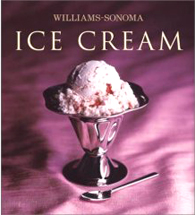 |
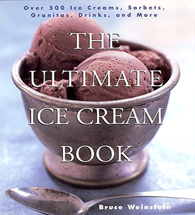 |
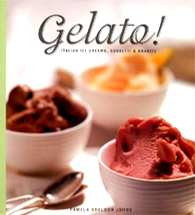 |
| Williams-Sonoma Collection: Ice Cream, by Mary Goodbody. More than 40 easy-to-follow recipes, from all-time favorites (lemon sorbet) to delicious new flavors (chocolate hazelnut gelato). The goal of this book is to inspire you to make your own ice cream—and we’ve recommended some of our favorite ice cream makers below, too. Click here for more information. | The Ultimate Ice Cream Book: Over 500 Ice Creams, Sorbets, Granitas, Drinks, And More, by Bruce Weinstein. Recipes for just about every ice cream imaginable, from four different versions of vanilla to corn, avocado, and oatmeal. There’s a different recipe to keep ice cream lovers busy for a year and a half, including one for homemade ice cream cones. Click here for more information. | Gelato!, by Pamela Sheldon Johns. Johns, an expert in the foods of Italy, clearly loves her subjects. With spectacular recipes handed down from generations, and fascinating stories from Italian gelato artisans—plus gorgeous photography—this is a volume for any ice cream-lover’s collection. Click here for more information. |
Favorite Ice Cream Makers
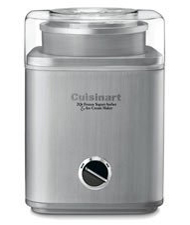 |
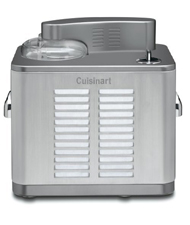 |
CUISINART ICE-30BC. Makes two quarts of ice cream in under 25 minutes. Just add your favorite fruit, nuts or chips, turn the machine on, and you can enjoy the frozen desserts of your dreams in almost no time. Click here to purchase or for more information. |
CUISINART ICE-50BC. Make one and half quarts of ice cream, frozen yogurt or sorbet without having to wait between batches. This ice cream maker even features a fully automatic 60-minute timer and does not require pre-chill or pre-freezing. Click here for more information. |
FOR ADDITIONAL INFORMATION, special offers, contests, opinion surveys, THE NIBBLE prior issues archive, product gift-finder and more, visit the home page of TheNibble.com.
Do you have friends who would enjoy THE NIBBLE? Click here to send them an invitation to sign up for their own copy. |
ABOUT THE NIBBLE. THE NIBBLE™, Great Food Finds™, is an online magazine plus newsletters about specialty foods and the gourmet life. It is the only consumer publication and website that focuses on reviewing the best specialty foods and beverages, in every category. The magazine also covers tabletop items, gourmet housewares, and other areas of interest to people who love fine food.
© Copyright 2004-2026 Lifestyle Direct, Inc. All rights reserved. All information contained herein is subject to change at any time without notice. All details must be directly confirmed with manufacturers, service establishments and other third parties. This materialmay not be reproduced, distributed, transmitted, cached, or otherwise used, except with the prior written permission of Lifestyle Direct, Inc.




